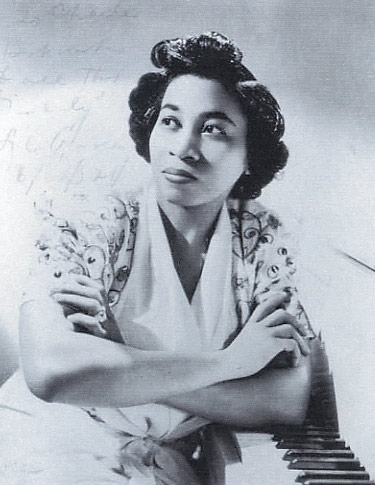
Portrait of Lil Hardin. Photo courtesy of the Frank Driggs Collection.
In the 1920s she was known as “Hot Miss Lil.” Today Lil Hardin is noteworthy as one of the most prominent women in early jazz. A pianist, composer, arranger and bandleader, Hardin was also a guiding light for her husband—Louis Armstrong. On this edition of Riverwalk Jazz, we salute the incomparable Lil Hardin Armstrong with a series of rare interviews recorded in the 1950s in which she talks about her life in music and her marriage to the great jazzman. These interviews were first released on the Riverside LP, Satchmo and Me.
BONUS AUDIO CONTENT
If Lil Hardin Armstrong’s name comes up today, it’s almost always because of her famous last name. In the jazz world of the 1920s women, especially black women were relegated to singing or dancing in the chorus line, but Lil Hardin had a serious career as a respected jazz composer, pianist and bandleader long before her marriage to Louis Armstrong. Lil worked with prominent black bands in Chicago; she performed with Sugar Johnny’s Creole Orchestra, Freddie Keppard’s Band and she led her own band at the Dreamland Café. Lil often fronted recording groups including the New Orleans Wanderers, with whom she recorded her 1926 tune “Papa Dip” —a number she named after Louis Armstrong.
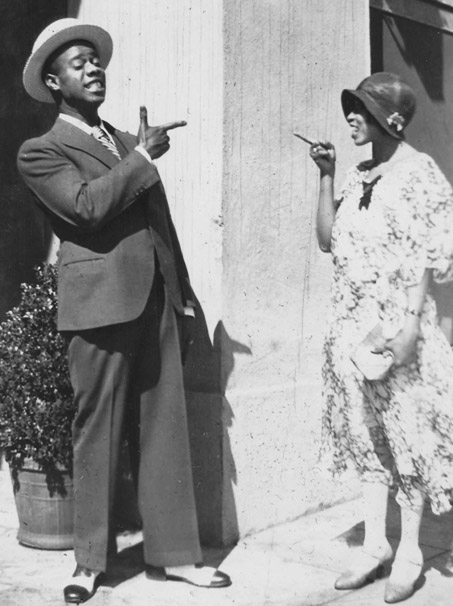
Lil and Louis met in Chicago in 1923. Photo courtesy of the Frank Driggs Collection.
Lil and Louis were band mates in King Oliver’s Creole Jazz Band when they married in 1924. Louis was the new kid in town and Lil the established player on the Chicago jazz scene. Lil Hardin was not impressed with Louis on first sight. In a recorded interview heard here, she says that ‘Louis was too fat and had a funny hairdo.’ Nonetheless, she was won over by his charm and talent, and within the year Louis and Lil had married. Lil Hardin saw tremendous potential in Louis Armstrong’s playing that he couldn’t see himself. Early on, she was the driving force behind his bookings and helped launch Armstrong as a star soloist. She insisted that he leave King Oliver and strike out on his own.
There’s a photograph of Lil taken when she was with King Oliver’s Creole Jazz Band in the early 1920s. She’s a petite, lady-like figure, perched on a piano bench. In contrast, she’s surrounded by the beefy, worldly-wise musicians in Oliver’s band. You can see in a flash why Hardin’s mother was dead set against her daughter taking a job with these guys. Lil was, after all, a classically trained musician who had studied at Fisk University. Some of these jazz musicians could barely read music. Lil surprised the musicians in Oliver’s band with her talent. Louis Armstrong once made this remark about Lil: “It was startling to find a valedictorian fall in line and play such good jazz.” Playing every night on the South Side of Chicago, King Oliver’s band drew standing room only crowds, including white musicians from the North Side like cornetist Bix Beiderbecke and tunesmith Hoagy Carmichael. Lil says, “They would listen so intently, and I didn’t know what they were trying to listen to. Now I know.”
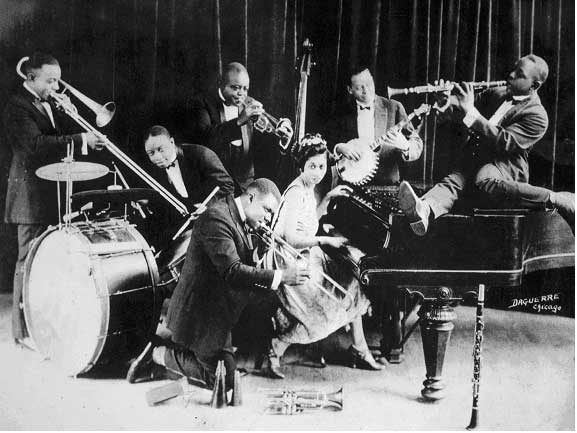
King Oliver's Creole Jazz Band, 1923. Photo courtesy of redhotjazz.
Lil Hardin’s background was very different from the hardcore poverty Louis Armstrong knew as a child. Lil was born in 1898 in Memphis, TN. Though her mother worked as a maid, she gave her kids a comfortable and somewhat refined life. She made sure that Lil attended Mrs. Hicks’ School of Music and the prestigious Fisk University. Lil’s mother favored hymns and popular songs and banned Lil from having anything to do with jazz and blues when she was a teenager. Ironically, in 1918 Lil’s mother moved her family to Chicago—a center of the burgeoning jazz universe and a magnet for the best New Orleans players. Lil soon found a job at a music store where she met piano giant Jelly Roll Morton and Chicago’s top jazz bandleader King Oliver. Before long Lil made a good living as a jazz piano player in spite of her mother’s initial objection to the genre.
Lil and Louis’ marriage and musical partnership began to come apart in 1930. Louis was on the road almost every night of the year— and it took a toll on their home life. The next stop for Louis was New Orleans, where headlines in the local paper played up the ‘hometown hero’ angle, making much of the fact that Louis had sold newspapers in the Crescent City as a kid. According to Lil, Louis had changed his outlook on life, complaining that Lil was “too old fashioned.” They split and Lil returned to Chicago.
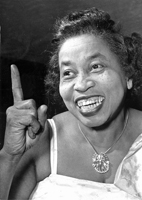
Lil Hardin. Photo by Helge Mass.
Lil continued to have a rich career in music after her separation from Louis in 1931; they finally divorced in 1938. Lil appeared in several Broadway shows and made a series of vocal sides for Decca records. In the late 1960s Lil backed off from the music business, and spent more and more time in a place she and Louis bought in the early years of their marriage in the lake resort town of Idlewild, Michigan. In July 1971 Louis Armstrong died. Only a month later in August 1971, Lil was performing at a memorial concert for Louis in Chicago, when she collapsed and died on stage. So ends one of the great love stories of jazz.
In an interesting footnote to our story, seven years after she died, a song composed by Lil Hardin Armstrong topped the pop charts all over the world. Ringo Starr recorded her composition “Bad Boy” in 1978 and it was on the radio everywhere. No doubt Lil would have enjoyed that immensely.
More about the music on this broadcast:
“My Heart,” composed by Lil Hardin, was first conceived as a waltz in ¾ time; but Louis and Lil always played it as a hot jazz piece in 4/4 time. Our version features The Jim Cullum Jazz Band with special guests Chicagoan Mike Walbridge on tuba and Bay Area cornetist Leon Oakley. The addition of tuba and second cornet duplicates the lineup of the great King Oliver band as it was configured in Chicago in the early 1920s.
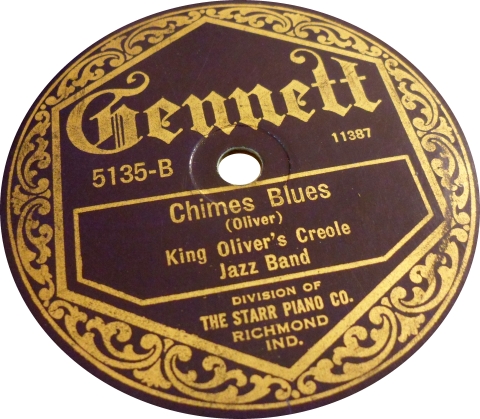
Gennett record label image courtesy of indiana.edu.
The original Oliver recording of “Chimes Blues,“ as arranged by Lil Hardin, contained the first recorded solo by Louis Armstrong. Heard here, our tribute features the great trumpeter Doc Cheatham with The Jim Cullum Jazz Band.
Though “Come Back Sweet Papa” was first recorded in 1926 after Louis Armstrong had left the Oliver band, our rendition on this broadcast features instrumentation consistent with King Oliver’s Creole Jazz Band.
“Skid-dat-de-dat“ was a Hot 5 collaboration composed by Lil Hardin and Louis Armstrong; and recorded by the Hot 5 in 1926.
“Mabel's Dream,” originally recorded by King Oliver in 1923 with Lil Hardin on piano; the version heard here features the expanded Oliver configuration of The Jim Cullum Jazz Band with Mike Walbridge on tuba and Leon Oakley on cornet.
The interpretation of “Ory's Creole Trombone“ heard on this broadcast features long-time Cullum Band trombonist Mike Pittsley. The tune was one of the original Armstrong Hot 5 numbers recorded in 1927 for the Okeh label and released on 78rpm discs.
“Struttin' with Some Barbecue“ is also a Hot 5 classics. Like many early New Orleans tunes, the title contains an impolite sexual reference. The trumpet soloist on our rendition is Jon-Erik Kellso, a leading champion of classic jazz in New York City.
The hymn-like “Riverside Blues“ was composed by Richard M. Jones and Thomas A. (“Georgia Tom”) Dorsey in Chicago for King Oliver, who recorded it in 1923 shortly before Louis and Lil left his band.
“S.O.L. Blues” was an original Hot 5 number. Our version features Australian cornet master Bob Barnard.
Photo credit for Home Page: Lil Hardin. Photo courtesy of the Frank Driggs Collection.
Text based on Riverwalk Jazz script by Margaret Moos Pick ©2000

